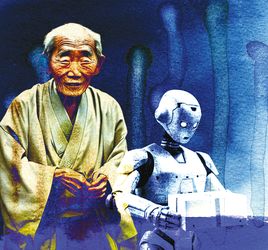The child follows the moving object with its eyes. The girl sashays on the catwalk, smiles, then pouts. The child and girl are not human. They are robots made in Japan and they demonstrate the nation’s way of innovating out of crises.
Japan has the world’s fastest ageing society—one-third of its population are over 65 years old. Simultaneously, decreasing birth rate is creating massive labour shortages. Japan’s solution to this double whammy is evident in a statistic: it has the world’s highest number of robots. The void caused by ageing and unborn Japanese is being filled by AI, robots and avatars. Japan already has robots, androids and humanoids in hospitals, factories, schools, security services, and even outer space. It “employs” 2.5 lakh industrial robotic workers, set to increase to 10 lakh in a decade. All Japanese corporate giants manufacture robots and they dominate the international market.
In 2008, Japan’s population peaked at 129 million. It is projected to decrease by 10 million a decade, plummeting to 77 million in 50 years—40 per cent less than today. Warns economist Masakazu Toyoda, “Japan’s GDP will shrink, economy will decline and we will be bankrupted by the caring costs for the ageing population. Geopolitically, Japan would have to survive as a middle power in a tough neighbourhood. It could also lead to a security crisis. Pax America is in decline, no one can stop the crisis in Ukraine or Gaza. Everyone must defend themselves. But Japan’s self-defence service is unable to recruit sufficient numbers.”
Efforts to increase birth rate by providing child allowances and free college education for the third child have not succeeded in Japan or elsewhere. Migration has improved birthrates in the US and the UK, but migration is taboo in Japan. Most Japanese find the invasion of foreign residents with their alien tongues and loud behaviour into their orderly, polite, silent cocoon, disagreeable. Regarding themselves as a “pure race”, many Japanese shun intercultural marriages, pejoratively referring to children born of such wedlock as “halfu” (half). Besides, migration in most western countries is hardly inspiring.
Avoiding immigration, the Japanese prefer the robot route to fill the labour gap. Innovative Japan has a history of skilled craftsmanship. Mechanical dolls, a precursor to today’s robots, were invented 300 years ago. In 1972, Japan invented the world’s first humanoid intelligent robot. To disarm public fear of robots, manufacturers also make adorable seals, dogs and cute, comic book manga-style female robots with big eyes and girly fringes.
But in construction, farming and retail, labour shortage extracts a price. The construction of the prestigious Osaka World Expo, scheduled to open in 2025, is facing delays and cost overruns—the bill has doubled to $1.6 billion. Despite raising wages, enticing women into the work force and designing stylish uniforms, construction workers declined 30 per cent in 25 years. Many 20th century inventions are fading out. Food trolleys in trains have disappeared and vending machines are not refilled for days. Farms are abandoned and whole villages depopulated because 43 per cent of farmers are over 75.
Japanese innovators experiment to mitigate, if not solve the problem. The solar-powered robot duck churns weeds to help rice cultivation. Human hours involved in this process fell from 529 to 29. Omnipresent convenience stores provide everything from rice balls to hangover cures to grateful Japanese commuters. In a new trend, a smiling attendant greets customers—from a four-foot screen. Like the living attendants of yore, the avatar’s eyes unobtrusively follow the moving human objects—scanning for shoplifting.
Pratap is an author and journalist.


